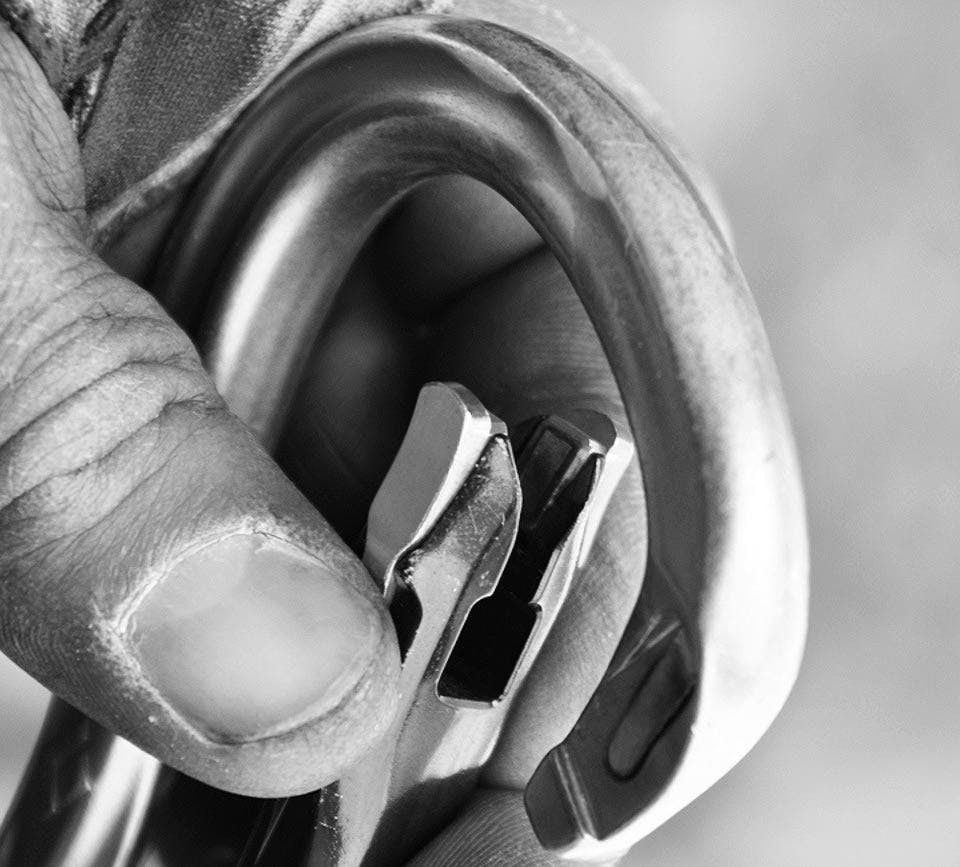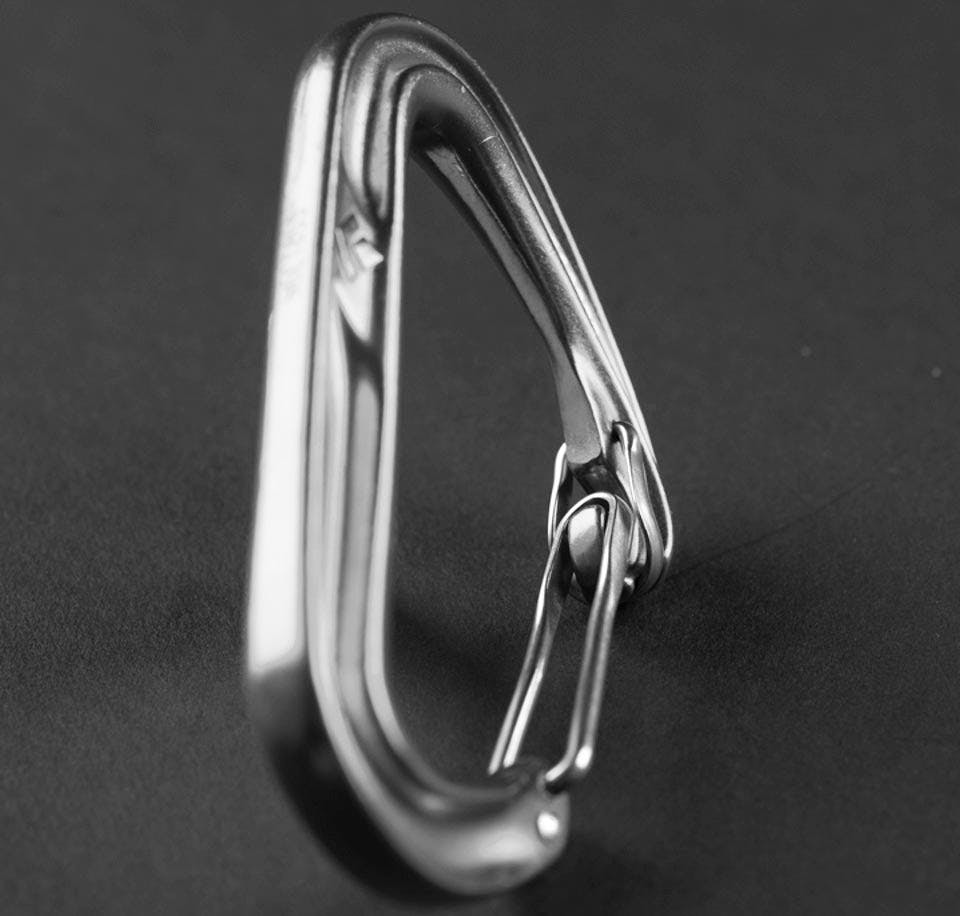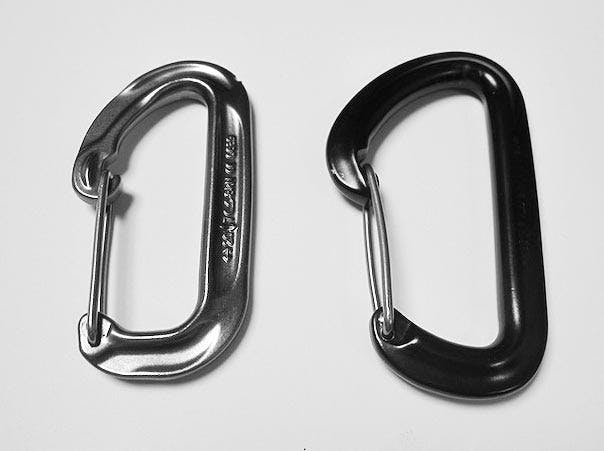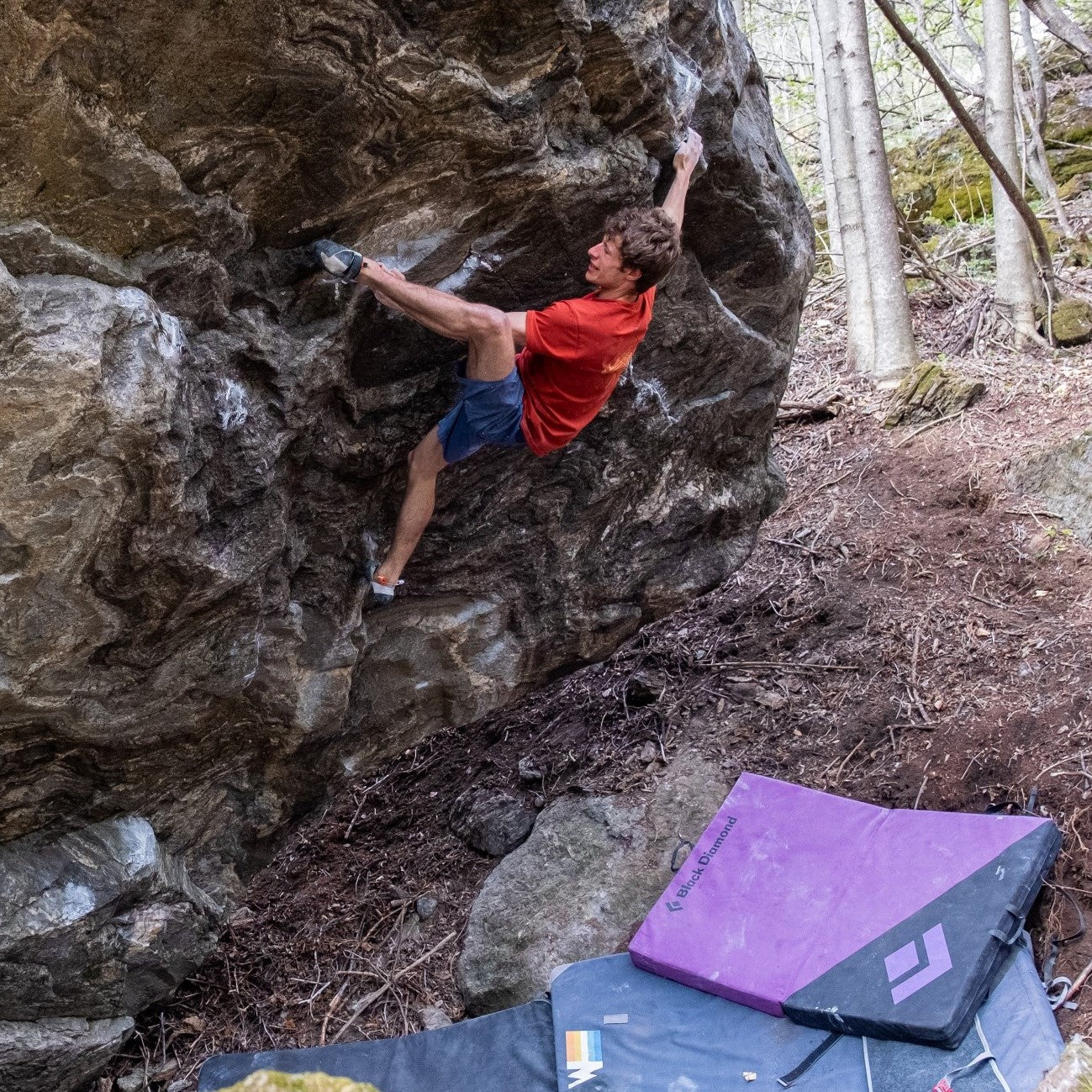
WHAT TO WEAR BACKCOUNTRY SKIING
Dial in your kit for the skin track.
Add 100 EUR more to quality for free Shipping!
€0,00 EUR

With dozens of companies making untold numbers of carabiners these days, it can be a real chore to navigate through countless different models to choose the one that's right for your type of climbing. Wiregate vs. standard gate. AutoLock vs. screwgate. Ultralight vs. heavy. What biners should I use on my slimmed-down alpine rack as opposed to my daily sport cragging kit? As with most pieces of climbing gear, there is a certain amount of inherent versatility, but often certain products are better suited, and more often than not designed specifically for certain applications. As with almost anything, it's always prudent to select the right tool for the job. This month we'll attempt to distill the basics of carabiner usage to help you figure out what's the right choice for your type of climbing.
We'll start off with a quick word on basic carabiner use because we get this question all the time.
I get lots of random calls from arborists, fire departments, rescue workers, marinas, yachting folks, Jeep guys and warehouse personnel wanting to know if it's okay to use our carabiners for their particular application. The official answer is always no, not recommended. Just as all of our instructions say, our gear is "For Climbing and Mountaineering Only." But why?
The simple answer is that we are climbers and mountaineers, we know climbing and mountaineering, and we design, test and certify our gear for climbing and mountaineering. We're not as intimate with the loads, the uses, misuses and abuses of these other applications.
What many people may not realize is the different ways that recreational gear is designed, tested and rated compared to industrial equipment. Industrial connectors are usually made of steel, are much heavier, are often much stronger, certified to different standards, and are sometimes rated differently than aluminum climbing carabiners.
Depending on what standard an industrial connector is certified to, and it’s intended application, it may be rated to either it’s Safe Working Limit (SWL) and/or it’s Minimum Breaking Strength (MBS). The steel connector on the left in the photo below has an MBS of 45kN - if it sees a load of 45kN, it will break. However, if a connector is marked with it’s SWL, it will have a safety factor included which could be anywhere from a factor of 4 and up. For example, let’s say a steel industrial connector is marked with a SWL of 10kN and is certified to an industrial standard which requires a safety factor of 4. This means that you can load the connector safely to 10kN - and that it won't actually break until a minimum of 40kN. However, climbing gear is always rated to the load at which it will actually break. So a 20kN carabiner actually breaks at that load. There's a big difference.
Bottom line: Climbing gear shouldn't be used in industrial applications—it just isn't designed, rated or certified for those types of loads and applications.

As far as carabiner "strength" is concerned, almost every carabiner available today is CE certified. This means they meet minimum strength requirements. A bunch of smart people have spent a lot of time determining what these standards should be, given real-world climbing and mountaineering loading scenarios. There are some subtle differences and exceptions when getting into the nitty gritty of different kinds of carabiners, but for argument's sake, the minimum strength requirements for most climbing carabiners are:
Closed gate strength - 20kN
Open gate - 7kN
Minor axis - 7kN

Though in theory loads at the belay can reach 20kN, this is extremely rare and likely caused because something didn't go right. Is a 24kN carabiner stronger than a 20kN carabiner? Yes. Does it matter? In most cases, likely not.
Now open-gate and minor-axis strengths for most carabiners are much less (about a third) than closed-gate, and are in the ranges that can actually be seen in the field. So a higher open-gate or minor-axis rating isn't necessarily a bad thing, but once again, all biners sold are going to meet the minimum requirements.
Even within the climbing and mountaineering carabiner world, how do you know which model or style to choose? Black Diamond alone manufactures over 30 different styles of carabiners. From belay-specific biners, lockers, wiregates, keylock and traditional-gate biners, to biners with "hoods" and now even carabiners with magnets. How is someone to know what is the right tool for the job? I'll speak mainly to Black Diamond's offering of carabiners because that's what I use and know best.
Belay Biners
Belay biners, also known as HMS biners, are always lockers, and typically have a large basket end to accommodate using a Munter hitch. There are heavier, larger versions usually made from a larger diameter rodstock, and there are smaller, often lighter versions which usually have a more aggressive I-beam construction-this puts material where it is needed to attain the required strength, but removes excess material from where it is not needed, resulting in a lighter biner. Larger diameter carabiners usually last longer as there is a consistent, larger rope-bearing surface to wear evenly, whereas lighter I-beam carabiners tend to show signs of rope wear more quickly due to the geometric differences where the rope runs.
I like the Rocklock or MiniPearabiner for my standard workhorse Belay biner, a Gridlock for use with a GriGri, and a Vaporlock for multipitch rock, ice or in the alpine.
Lockers
There are several different types of locking mechanisms available on the market today. As far as Black Diamond carabiners are concerned, these include:

As well as the different types of locking mechanisms described above, there are two general families of lockers: big and small. Typically large lockers are used for belaying (as stated above), setting up top ropes, or acting as the power point in anchors. Smaller lockers are often used to build anchors, on a particular placement where you could be concerned about the gate opening, or to clove yourself into an anchor.
Wiregate vs Non-Wiregate
In 1995, Black Diamond brought wiregate technology to the climbing industry with the HotWire carabiner. Wiregate carabiners are typically lighter, less susceptible to freezing, and because of the reduced mass, less susceptible to gate whiplash. During a climbing fall there is a lot going on-carabiners are getting loaded, ropes are stretching and getting tight, things are bouncing around. Traditional gates on carabiners have more mass to them, and during all of this bouncing and vibration, it has been shown that the mass of the gate can allow it to open slightly which in effect results in an 'open gate' loading scenario. And as stated above, carabiners are typically 3 to 4 times as strong when the gate is closed. The reduced mass of a wiregate carbiner alleviates this.
Personally I like the fact that wiregate biners are usually lighter and less susceptible to freezing so I typically use them for long routes with long approaches, and ice or alpine climbing.
Keylock Gate vs. Non-Keylock Gate
Carabiners historically used a 'hook and pin' configuration to allow the gate to interface with the body of the biner and give it its strength during closed-gate loading. This style is consistent, strong, relatively easy to manufacture and relatively cheap.

Another solid gate design came on the scene several years ago-the keylock gate. This uses the geometry of the pocket of the gate to interface with the 'nose' of the carabiner to provide its strength in closed gate. The advantage of this design is that it alleviates the chance of the hooked part of the carabiner to get hung up on something (like a bolt hanger, Stopper wire or sling). Nose hooked carabiners are surprisingly weak, and it's by far the most common scenario for carabiner failure in the field. Check out an old QC Lab post on the subject.
The manufacturing process for making keylock gates is slightly more expensive, but you gain the benefit of a snag-free carabiner.
Until recently, if you were the type of person that really liked the snag-free keylock design, but also the lighter weight and no whiplash of the wiregate, you had to make a choice. But now BD's HoodWire Technology kills two birds with one stone. You get the functionality of a wiregate carabiner as well as the snag-free benefits of a keylock thanks to the carabiners simple wire hood. HoodWire Technology is available on both the HoodWire carabiner, as well as our updated Oz Carabiner.

Heavy vs. Light
When our Oz carabiner first came out, my buddy Travis called me up all excited, "I'm going to order a full set of Oz quickdraws for my new sport climbing kit. They're so light!" It's true the Oz is a super-light biner at one ounce (hence the name), but is it the right choice for your sport climbing draws? Sure, if you're doing a multipitch sport route in the Canadian Rockies, or going for a hard, 22-draw onsight, go for it. But for a workhorse sport climbing carabiner, it's probably not the best choice. Why? In order to get the weight out of these lightweight biners, manufacturers are removing material, and though ultimately all carabiners are strong and meet all CE requirements, less material can mean a few things. The smaller size makes is slightly harder to clip. There can be less material in the spine, which makes it more susceptible to bending if loaded over an edge, and there oftentimes is less material on the rope-bearing surface, which means whippers are harder on your rope.
A quickdraw that is more optimized for daily cragging would likely have a snagfree carabiner on the top so it doesn't get up on bolt hangers, and a nice large biner on the bottom for ease of clipping. Something like the sport climbing specific Livewire Quickdraw,, Nitron Quickdraw or Hoodwire Quickdraw.
We headed down to the drop tower to do a quick comparison of a few different manufacturer's workhorse-type biners side-by-side with several different lightweight rigs. The intent was to determine how many gnarly factor-1.7 drops, with a static belay, without moving the rope at all, would it take to trash a rope or trash the biner.

For most of the larger, heavier biners, the rope actually eventually ended up cutting, and the biner was still in good enough shape to throw on your rack and keep climbing. Whereas with the lightweight, smaller biners, after anywhere from 3-5 drops, the biner was severely deformed and was what I would consider non-functional (gate wouldn't open), and on a few occasions, the 10mm Dynex sling eventually cut.

Obviously this test is brutally harsh-no one in their right mind would (or could) take repeated gnarly fall factor-1.7 whippers with a static belay onto the same section of rope—but comparatively speaking, the lightweight biners got thrashed earlier. What's the moral of this story? Use the right tool for the job. Heavier biners with a greater cross section have their place as they are burly and can take abuse. Use something like this for your daily cragging quickdraws where you're more likely to fall repeatedly working the moves on your big proj. Whereas the smaller sized, lightweight biners aren't designed to withstand the same level of abuse and are more appropriate when weight is a concern, and you're not as likely to be taking huge lobbers repeatedly, like in the alpine, or when ice climbing.
Of course any rated carabiner can be used for multiple purposes, but like most climbing gear, they are often designed for a specific or intended use. Choosing the right biners for the type of climbing you're doing will benefit you in the end-a rack of light wiregates on an alpine route will help you move faster, burly sport climbing biners will extend the life of your gear, etc. As with almost anything, it pays to have the right tool for the job.
Stay safe out there,
KP






Follow BD Athlete Yannick Glatthard deep into the Swiss Alps as he shares his home...
Follow BD Athlete Yannick Glatthard deep into the Swiss Alps as he shares his home mountains with close friends.

Follow Dorian Densmore and Mya Akins for another winter season of steep Alaskan spines, backyard...
Follow Dorian Densmore and Mya Akins for another winter season of steep Alaskan spines, backyard couloirs, and deep adventures in the mountains.


Watch BD Athlete Alex Honnold throw down on some hard trad high above Tahoe.



In 2012, filmmaker and photographer Ben Ditto, and professional climber Mason Earle equipped an immaculate...
In 2012, filmmaker and photographer Ben Ditto, and professional climber Mason Earle equipped an immaculate line in Tuolumne’s high country. But their attempts to free the route were thwarted when Mason’s life changed drastically. With the help of Connor Herson, Ditto and Mason found a way to keep the dream alive.


Watch and learn as our Field Test Coordinator runs you through a step by step...
Watch and learn as our Field Test Coordinator runs you through a step by step process of trimming and setting up any STS-style Black Diamond skin.


Every climber has a few lines they dream about. Whether inspired or haunted—or sometimes both—these...
Every climber has a few lines they dream about. Whether inspired or haunted—or sometimes both—these lines can push us beyond what we thought we were capable of, in turn teaching us who we really are. BD Ambassador Ethan Salvo recently restructured his entire life to focus on two climbs that pulled him into the void with only one way out … getting to the top. This is his story of sending Dreamcatcher and becoming the first Canadian to climb V16 in the same week.

BD Athlete Connor Herson spent as many weekends as possible in the Valley this spring...
BD Athlete Connor Herson spent as many weekends as possible in the Valley this spring during a grueling quarter at Stanford. The objective? Ground up, in-a-day ascents.

